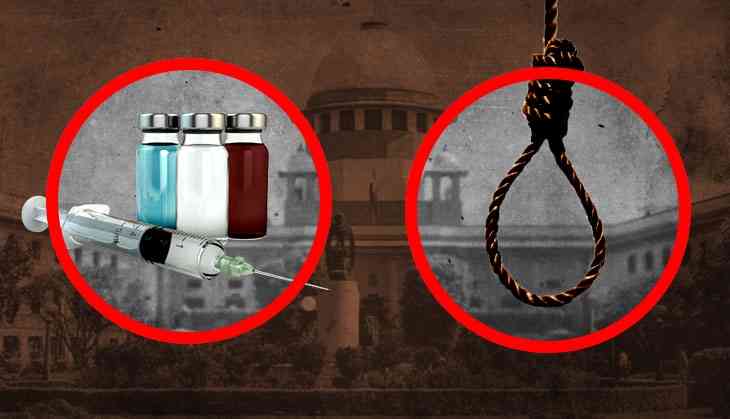Noose the best bet for execution: Centre to Supreme Court

The Narendra Modi government backed continuing to execute the capital punishment by hanging by the neck, over other means, particularly lethal injection. Tuesday it told the Supreme Court that making the process of death penalty comfortable and serene would reduce it as a deterrence against abhorrent criminal acts.
The Centre's submission was in response to a public interest litigation (PIL) seeking abolition of hanging as mode of executing death row convicts and replacing it with more “humane” method like a lethal injection.
Filed by advocate Rishi Malhotra, the PIL seeks declaring “right to die through a dignified procedure of death” as a fundamental right. It contends that the practice of hanging as a mode of execution is “ultravires” of the Article 21 of the Constitution that guarantees Right to Life and Personal Liberty.
The petition contends that Section 354(5) of the Criminal Procedure Code (CrPC) which provides for hanging by the neck as the mode of execution, was not only “barbaric, inhuman and cruel” but also against the resolutions adopted by the United Nations Economic & Social Council (ECOSOC) which provides for inflicting “minimum possible suffering” in carrying out capital punishment.
In its counter-affidavit, filed through, Ministry of Home Affairs Joint Secretary Vinoy Bhushan Dubey, the Centre said the matter pertains to sensitive issues which are exclusively a matter of legislative policy and ought not to be entertained in a PIL.
“Making the entire process of death penalty overly comfortable, serene and painless for the convict may substantially reduce its effectiveness in acting as a deterrent against abhorrent criminal acts as was intended by the legislature and may not be able to serve its social purpose.
“Capital punishment is confined to a bare minimum and there is large number of cases where death sentences were commuted to life sentence. Only three executions have been carried out during the years 2012 to 2015 and these are cases of those convicted of heinous offences of terrorism/waging war,” the Centre said.
Citing the SC verdict in Deena vs Union of India, the Centre said the apex court had held that hanging as a mode of execution was easy to assemble, quick and simple and free from anything that would unnecessarily sharpen the poignancy of the prisoner.
It also said hanging as a mode of execution ensures exclusion of chances of accidents and eliminates the possibility of a lingering death.
“Hanging also helps in avoiding to the full extent the chances of strangulation which results on account of too short a drop or of decapitation which results on account of two long a drop and thus consistent with the obligation of the state to ensure that the process of execution is conducted with decency and decorum without involving degradation or brutality of any kind,” the Centre said in the affidavit.
Countering the petitioner’s argument in favour of lethal injection, the Centre cited the example of the United States, where the mode of the execution has resulted in the most instances of botched up executions. It pointed to a report according to whoich out of 1,054 lethal-injection executions in the US, 75 were botched up – the highest compared with other modes, including hanging and electrocution.
“Lethal injection has also been contested on the ground that it may lead to uncomfortable death wherein the convict is unable to express his/her discomfort because of paralysis caused by the paralytic agent injected. It is believed by many, that lethal injection is designed to create only an appearance of serenity and painless death.
“The procedure followed for execution by electrocution or lethal injection or firing squad could be just as inhumane or barbaric to another person. As far as likelihood of execution getting botched up is concerned, the statistic show that hanging with more advanced procedures is for safer than techniques such as lethal injection,” said the Centre.
Countering the petitioner’s contentions, the Centre said declaring section 354 (5) CrPC as unconstitutional would create a vacuum in law and lead to a “moratorium on death sentences with several convicts on death row which is highly undesirable”.
The Centre also countered to the petitioner’s reliance on the observations of the Law Commission of India’s 187th report (2003) which opined that “hanging undoubtedly is accompanied by intense physical torture and pain”.
The Centre in this regard contended: “Medical professionals are unlikely to participate in execution in lethal injection. Getting the job done by untrained people is fraught with substantial risk and uncertainty”.
“The possibility of failure of the chemical which will be use for such lethal injection has not been factored, similarly there are problems of finding the right vein, right doses and other associated complications. There have been several instances in the American states of Florida, Ohio and Oklahoma where such complications have arisen,” it said adding that the the key issues of technical requirements being available at the jail for conducting such mode of execution was not been taken into account by the Law Commission.
On firing squad as a mode of execution, the Centre said it not fail-safe and can be extremely painful if the shooters miss the heart by accident or intentions the prisoner bleeds slowly to death.

